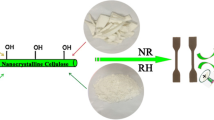Abstract
Plant cellulose (PC) and used tire rubber powder (RP) were used as raw materials for preparing RP/PC composites, and the interface compatibility between PC and RP was studied. The compatibility was modified by adding r-aminopropyltrieth oxysilane (KH550) and bis-(γ-triethoxysilylpropyl)-tetrasulfide (Si69) coupling agent. The structure and morphology of RP/PC composites were characterized by scanning electron microscopy and their compatibility was preliminarily judged. The cross-linked structure and components of composite materials were studied by an infrared spectroscopy, X-ray photoelectron spectrometer and dynamic mechanical thermal analysis. The best coupling agent to improve the compatibility between RP and PC is Si69, and its best content is 2.5 phr. The composites treated with Si69 combine more closely and leave less space, and the interface compatibility between RP and PC is obviously improved.








Similar content being viewed by others
References
Ade RK, Denis R (2014) Impact modification of polypropylene-based composites using surface-coated waste rubber crumbs. Polym Comp 35:2280–2289
Eskinder DG, Eskinder DG, Isabela B, Jordi G (2013) A comparison of the GHG emissions caused by manufacturing tissue paper from virgin pulp or recycled waste paper. Int J Life Cycle Ass 18:1618–1628
Li MJ, Zhu WH, Xu YW, Fu MS, Cao YH (2014) Preparation and damping properties of (waste rubber powder)/hindered phenol composites. J Vinyl Addit Tech 20:225–229
Łukasz P, Aleksander H, Krzysztof F, Magdalena D, Michał S (2015) Effect of ground tire rubber on structural, mechanical and thermal properties of flexible polyurethane foams. Iran Polym J 24:75–84
Marjan G, Mehrdad K (2015) Sound barrier properties of sustainable waste rubber/geopolymer concretes. Iran Polym J 24:105–113
Nabil H, Ismail H, Azura AR (2014) Thermal stability and aging characteristics of (natural rubber)/(waste ethylene-propylene-diene monomer terpolymer) blends. J Vinyl Addit Tech 20:99–107
Wu WL, Zhang J (2012) Preparation and characterization of environment friendly used rubber powder modified pulp sediments composites. Iran Polym J 21:763–769
Wu WL, Zhang J (2013) Preparation of waste tire powder/plant fiber composites and its property. China Pap Pap Mak 32:40–42
Acknowledgments
This work was supported by the 2013 Science and Technology Research Projects of Heilongjiang Province Educational Department, China (12531772).
Author information
Authors and Affiliations
Corresponding author
Rights and permissions
About this article
Cite this article
Wu, W., Zuo, H. Used tire rubber powder/plant cellulose composites treated with coupling agent. Cellulose 23, 1939–1947 (2016). https://doi.org/10.1007/s10570-016-0952-8
Received:
Accepted:
Published:
Issue Date:
DOI: https://doi.org/10.1007/s10570-016-0952-8




